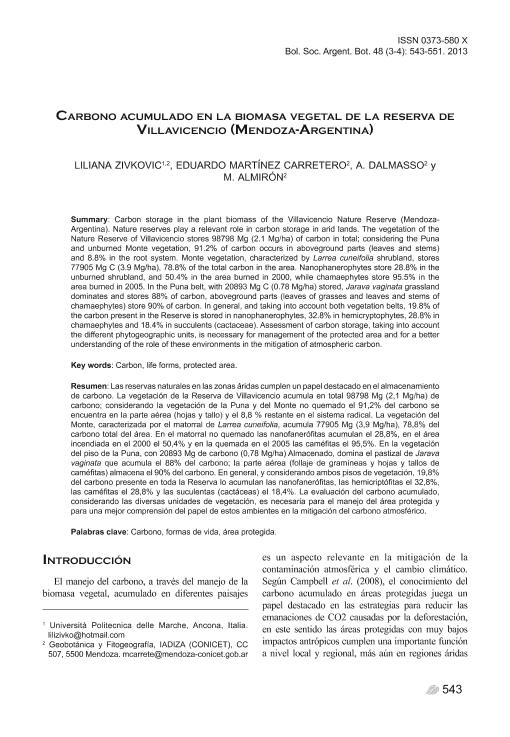Artículo
Carbon storage in the plant biomass of the Villavicencio Nature Reserve (MendozaArgentina). Nature reserves play a relevant role in carbon storage in arid lands. The vegetation of the Nature Reserve of Villavicencio stores 98798 Mg (2.1 Mg/ha) of carbon in total; considering the Puna and unburned Monte vegetation, 91.2% of carbon occurs in aboveground parts (leaves and stems) and 8.8% in the root system. Monte vegetation, characterized by Larrea cuneifolia shrubland, stores 77905 Mg C (3.9 Mg/ha), 78.8% of the total carbon in the area. Nanophanerophytes store 28.8% in the unburned shrubland, and 50.4% in the area burned in 2000, while chamaephytes store 95.5% in the area burned in 2005. In the Puna belt, with 20893 Mg C (0.78 Mg/ha) stored, Jarava vaginata grassland dominates and stores 88% of carbon, aboveground parts (leaves of grasses and leaves and stems of chamaephytes) store 90% of carbon. In general, and taking into account both vegetation belts, 19.8% of the carbon present in the Reserve is stored in nanophanerophytes, 32.8% in hemicryptophytes, 28.8% in chamaephytes and 18.4% in succulents (cactaceae). Assessment of carbon storage, taking into account the different phytogeographic units, is necessary for management of the protected area and for a better understanding of the role of these environments in the mitigation of atmospheric carbon. Las reservas naturales en las zonas áridas cumplen un papel destacado en el almacenamiento de carbono. La vegetación de la Reserva de Villavicencio acumula en total 98798 Mg (2,1 Mg/ha) de carbono; considerando la vegetación de la Puna y del Monte no quemado el 91,2% del carbono se encuentra en la parte aérea (hojas y tallo) y el 8,8 % restante en el sistema radical. La vegetación del Monte, caracterizada por el matorral de Larrea cuneifolia, acumula 77905 Mg (3,9 Mg/ha), 78,8% del carbono total del área. En el matorral no quemado las nanofanerófitas acumulan el 28,8%, en el área incendiada en el 2000 el 50,4% y en la quemada en el 2005 las caméfitas el 95,5%. En la vegetación del piso de la Puna, con 20893 Mg de carbono (0,78 Mg/ha) Almacenado, domina el pastizal de Jarava vaginata que acumula el 88% del carbono; la parte aérea (follaje de gramíneas y hojas y tallos de caméfitas) almacena el 90% del carbono. En general, y considerando ambos pisos de vegetación, 19,8% del carbono presente en toda la Reserva lo acumulan las nanofanerófitas, las hemicriptófitas el 32,8%, las caméfitas el 28,8% y las suculentas (cactáceas) el 18,4%. La evaluación del carbono acumulado, considerando las diversas unidades de vegetación, es necesaria para el manejo del área protegida y para una mejor comprensión del papel de estos ambientes en la mitigación del carbono atmosférico.
Carbono acumulado en la biomasa vegetal de la reserva de Villavicencio (Mendoza-Argentina)
Zivkovic, Liliana; Martinez Carretero, Eduardo Enrique ; Dalmasso, Antonio Daniel
; Dalmasso, Antonio Daniel ; Almiron, Martin Guillermo
; Almiron, Martin Guillermo
 ; Dalmasso, Antonio Daniel
; Dalmasso, Antonio Daniel ; Almiron, Martin Guillermo
; Almiron, Martin Guillermo
Fecha de publicación:
12/2013
Editorial:
Sociedad Argentina de Botánica
Revista:
Boletín de la Sociedad Argentina de Botánica
ISSN:
0373-580X
e-ISSN:
1851-2372
Idioma:
Español
Tipo de recurso:
Artículo publicado
Clasificación temática:
Resumen
Palabras clave:
Carbono
,
Áreas Protegidas
,
Formas de Vida
,
Carbon
,
Life Forms
,
Protected Area
Archivos asociados
Licencia
Identificadores
Colecciones
Articulos(IADIZA)
Articulos de INST. ARG DE INVEST. DE LAS ZONAS ARIDAS
Articulos de INST. ARG DE INVEST. DE LAS ZONAS ARIDAS
Citación
Zivkovic, Liliana; Martinez Carretero, Eduardo Enrique; Dalmasso, Antonio Daniel; Almiron, Martin Guillermo; Carbono acumulado en la biomasa vegetal de la reserva de Villavicencio (Mendoza-Argentina); Sociedad Argentina de Botánica; Boletín de la Sociedad Argentina de Botánica; 48; 3-4; 12-2013; 543-551
Compartir



